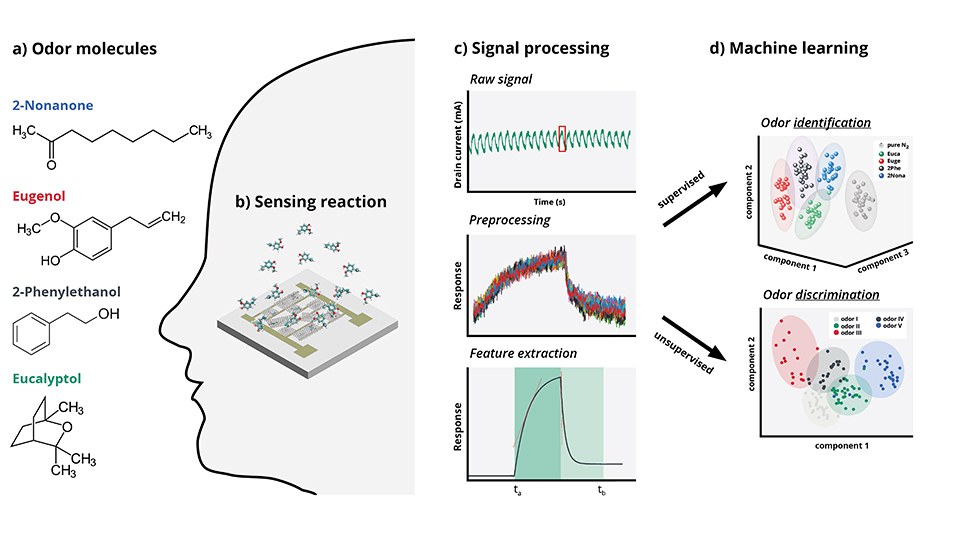
Scilight 2023, 201101 (2023)
by Maura Shapiro
The nose is a highly refined detector, sniffing out a wide range of volatile compounds at low concentrations. For even more sensitive applications, researchers often employ metal oxide gas sensors. However, these only operate at high temperatures and can only detect certain gases.
Huang et al. developed a graphene-based electronic sensor that uses machine learning to parallel the biological olfactory process. Their ’e-nose’ operates at room temperature and can detect a variety of gases and gas mixtures.

“An important challenge with gas sensors is their limited selectivity,” said author Shirong Huang. “Several gases may react with the sensors similarly, producing signal responses that are difficult to distinguish from each other.”
Instead, the authors’ e-nose utilizes graphene placed between electrodes with an applied electric current. When a volatile compound interacts with the graphene, it uniquely alters the current. A trained machine learning program identifies these olfactory fingerprints and determines the culprit.
To test the method’s effectiveness, the team put their e-nose through a so-called ’Turing test of digital olfaction,’ where the sensor identified specific scents from a collection of Sniffin’ Sticks and demonstrated the same or better capabilities as a biological nose.
Applications for e-noses are numerous, they can be miniaturized for portability and expanded to detect complex gas combinations.
“Our machine learning-enabled electronic olfaction platforms are suitable for performing diagnostic tasks in a non-invasive and rapid way, using the volatile compounds emanated by our body as indicators for specific diseases,” said author Gianaurelio Cuniberti. “In this way, one can detect severe and degenerative diseases like Alzheimer’s or Parkinson’s disease long before current standard methods do.”
Source: “Machine learning-enabled graphene-based electronic olfaction sensors and their olfactory performance assessment,” by Shirong Huang, Alexander Croy, Antonie Louise Bierling, Vyacheslav Khavrus, Luis Antonio Panes-Ruiz, Arezoo Dianat, Bergoi Ibarlucea, and Gianaurelio Cuniberti, Applied Physics Reviews (2023). The article can be accessed at https://doi.org/10.1063/5.0132177.

Scilight 2023, 201101 (2023)
by Maura Shapiro
The nose is a highly refined detector, sniffing out a wide range of volatile compounds at low concentrations. For even more sensitive applications, researchers often employ metal oxide gas sensors. However, these only operate at high temperatures and can only detect certain gases.
Huang et al. developed a graphene-based electronic sensor that uses machine learning to parallel the biological olfactory process. Their ’e-nose’ operates at room temperature and can detect a variety of gases and gas mixtures.

“An important challenge with gas sensors is their limited selectivity,” said author Shirong Huang. “Several gases may react with the sensors similarly, producing signal responses that are difficult to distinguish from each other.”
Instead, the authors’ e-nose utilizes graphene placed between electrodes with an applied electric current. When a volatile compound interacts with the graphene, it uniquely alters the current. A trained machine learning program identifies these olfactory fingerprints and determines the culprit.
To test the method’s effectiveness, the team put their e-nose through a so-called ’Turing test of digital olfaction,’ where the sensor identified specific scents from a collection of Sniffin’ Sticks and demonstrated the same or better capabilities as a biological nose.
Applications for e-noses are numerous, they can be miniaturized for portability and expanded to detect complex gas combinations.
“Our machine learning-enabled electronic olfaction platforms are suitable for performing diagnostic tasks in a non-invasive and rapid way, using the volatile compounds emanated by our body as indicators for specific diseases,” said author Gianaurelio Cuniberti. “In this way, one can detect severe and degenerative diseases like Alzheimer’s or Parkinson’s disease long before current standard methods do.”
Source: “Machine learning-enabled graphene-based electronic olfaction sensors and their olfactory performance assessment,” by Shirong Huang, Alexander Croy, Antonie Louise Bierling, Vyacheslav Khavrus, Luis Antonio Panes-Ruiz, Arezoo Dianat, Bergoi Ibarlucea, and Gianaurelio Cuniberti, Applied Physics Reviews (2023). The article can be accessed at https://doi.org/10.1063/5.0132177.